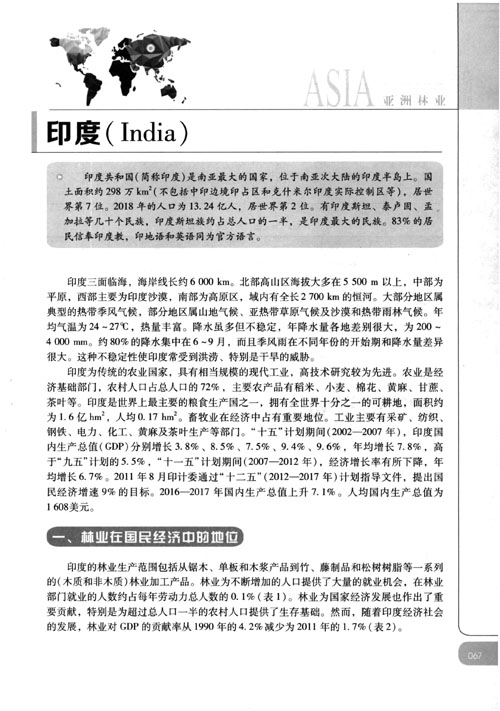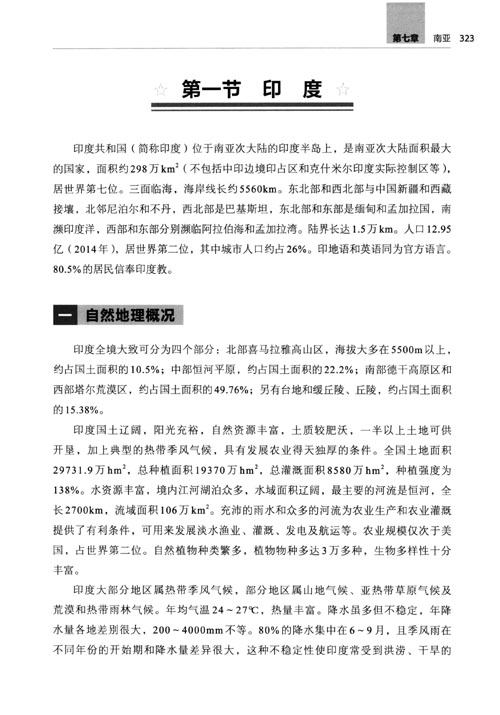
印度联合森林管理制度:经验与挑战
编号
lyqk009535


中文标题
印度联合森林管理制度:经验与挑战


作者单位
东北林业大学经济管理学院,哈尔滨 150040


期刊名称
世界林业研究


年份
2021


卷号
34


期号
4


栏目名称
各国林业


中文摘要
以人民参与和权利共享为基础,联合森林管理制度已经成为印度改善森林治理的旗舰计划。文中梳理印度联合森林管理制度的历史脉络,从林业政策、制度安排、权利改革、地方组织和冲突管理5个方面剖析其实施经验,总结现行联合森林管理制度在实践中面临的不足与挑战,并进一步探讨如何借鉴其成功经验完善中国的森林治理路径。


关键词
联合森林管理
社区林业
森林治理
权利共享
参与
印度


基金项目
中央高校基本科研业务费专项资金资助项目“重点国有林区经济转型过程中职工家庭的福利变化及生计模式研究”(2572015EC04);国家林业和草原局基金项目“东北虎豹国家公园政府购买生态服务模式研究”(JYCL-2020-00048);东北林业大学国家级大学生创新训练项目“东北虎豹国


英文标题
Joint Forest Management in India: Experiences and Challenges


作者英文名
Zhu Hongge, Chen Zhenhuan, Zhao Menghan, Ning Zhe, Zeng Pei


单位英文名
College of Economics and Management, Northeast Forestry University, Harbin 150040, China


英文摘要
With the focus on people's participation and rights-sharing, the joint forest management has become India's flagship plan to improve forest governance. The paper reviews the historical context of India's joint forest management regime, and analyzes its implementation experience in joint forest management from five aspects of forestry policy, institutional arrangement, rights reform, local organization and conflict management, summarizes the insufficiency and challenges confronted in practices, and further discusses how to improve China's forest governance by learning from its experiences.


英文关键词
joint forest management;community-based forestry;forest governance;benefit sharing;participation;India


起始页码
95


截止页码
100


投稿时间
2020/9/20


最后修改时间
2021/5/20


作者简介
朱洪革,男,副教授,博士生导师,研究方向为国有林区经济与政策,E-mail:honggebill@163.com


通讯作者介绍
宁哲,女,副教授,硕士生导师,博士,研究方向为林业经济管理,E-mail:nzld2007@163.com


E-mail
honggebill@163.com;nzld2007@163.com


分类号
S757.1,S7-9


DOI
10.13348/j.cnki.sjlyyj.2021.0035.y


参考文献
[1] CHANKRAJANG T. State-community property-rights sharing in forests and its contributions to environmental outcomes: evidence from Thailand's community forestry[J]. Journal of Development Economics, 2019, 138:261-273.
[2] OSTROM E. Governing the commons: the evolution of institutions for collective action[M]. New York: Cambridge University Press, 1990.
[3] APIPOONYANON C, KUWORNU J K M, SZABO S, et al. Factors influencing household participation in community forest management: evidence from Udon Thani Province, Thailand[J]. Journal of Sustainable Forestry, 2020, 39(2):184-206.
[4] SAIGAL S. Improving forest governance: experience of joint forest management in India[J]. Social Change, 2003, 33(2/3):29-40.
[5] 刘珉. 印度的联合森林管理战略[J]. 林业与生态,2017(9):24-27.
[6] 李维长. 印度发展社会林业的经验[J]. 南亚研究季刊,1991(3):52-58.
[7] BEHERA B, ENGEL S. Institutional analysis of evolution of joint forest management in India: a new institutional economics approach[J]. Forest Policy and Economics, 2006, 8(4):350-362.
[8] Ministry of Environment, Forest and Climate Change. Forest[EB/OL]. [2020-06-27]. http://moef.gov.in/forest-wildlife/forest-3/.
[9] Ministry of Environment, Forest and Climate Change. Forest conservation[EB/OL]. [2020-07-07]. http://moef.gov.in/rules-and-regulations/forest-conservation/.
[10] SARIN M, 赵文霞. 印度联合森林管理取得的成果和面临的问题[J]. 林业与社会,1996(3):16-17.
[11] KUMAR M, SINGH M P, SINGH H, et al. Forest working plan for the sustainable management of forest and biodiversity in India[J]. Journal of Sustainable Forestry, 2020, 39(1):1-22.
[12] KOLAVALLI S. Joint forest management: superior property rights?[J]. Economic and Political Weekly, 1995, 30(30):1933-1938.
[13] MUKHOPADHYAY D, TEWARI H R, ROY S B. Role of community institutions in joint forest management[J]. Journal of Human Ecology, 2007, 21(1):37-42.
[14] LAWRENCE A, GILLETT S. Encyclopedia of forest sciences[M]. Oxford: Elsevier, 2004: 1143-1157.
[15] KUMAR K, SINGH N M, KERR J M. Decentralisation and democratic forest reforms in India: moving to a rights-based approach[J]. Forest Policy and Economics, 2015, 51:1-8.
[16] BEHERA B. Explaining the performance of state–community joint forest management in India[J]. Ecological Economics, 2009, 69(1):177-185.
[17] KUMAR P, KANT S. Revealed social preferences and joint forest management outcomes[J]. Forest Policy and Economics, 2016, 72:37-45.
[18] BHATTACHARYA P, PRADHAN L, YADAV G. Joint forest management in India: experiences of two decades[J]. Resources, Conservation and Recycling, 2010, 54(8):469-480.
[19] SINGH V S, PANDEY D N, PRAKASH N P. What determines the success of joint forest management?: science-based lessons on sustainable governance of forests in India[J]. Resources, Conservation and Recycling, 2011, 56(1):126-133.
[20] BALAND J, BARDHAN P, DAS S, et al. Forests to the people: decentralization and forest degradation in the Indian Himalayas[J]. World Development, 2010, 38(11):1642-1656.
[21] CONROY C, MISHRA A, RAI A. Learning from self-initiated community forest management in Orissa, India[J]. Forest Policy and Economics, 2002, 4(3):227-237.
[22] SINGHAL R, RISHI P. Conflicts in institutional development: implications for joint forest management[J]. Forests, Trees and Livelihoods, 2003, 13(3):261-270.
[23] KASHWAN P. The politics of rights-based approaches in conservation[J]. Land Use Policy, 2013, 31:613-626.
[24] GUHA A, PRADHAN A, MONDAL K. Joint forest management in West Bengal: along way to go[J]. Journal of Human Ecology, 2000, 11(6):471-476.


发布日期
2021-05-24


PDF全文
浏览全文


-
相关记录
更多
- 拉美国家参与全球森林治理的3种模式——以REDD为例 2023
- 社会生态系统分析框架在世界森林治理研究中的应用及启示 2022
- 中国—东盟森林治理与合法木材贸易合作政策机制 2021
- 里山倡议及其在我国台湾地区的实践应用 2020
- 澜湄合作机制框架下的林业减贫研究 2020
- 中国台湾地区社区林业计划执行过程及内容 2019
 打印
打印




